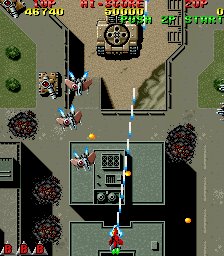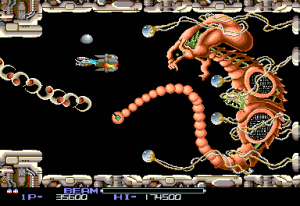Scrolling shooter
|
|
Scrolling shooters are a type of video game, a subgenre of the shooter or shooting game. The name of this subgenre is sometimes abbreviated to "shmup" (shoot 'em up), particularly in English-speaking portions of Europe. The term is less common (and even held in disregard) elsewhere.
| Contents |
Description
A scrolling shooter is, as the name suggests, a shooting game that takes place against a scrolling background.
There are several subclasses of this genre. For example:
- Horizontal scrollers (e.g. R-Type, Gradius, Darius), also known more simply as "horizontal shooters" or " side-scrolling shooters".
- 'Complex' scrollers (in which the player's orientation might change throughout the game (e.g. Axelay, Salamander)
- Multidirectional scrollers (in which the scrolling follows the player's movement, e.g. Desert Strike, Thrust, Sinistar)
Horizontal and vertical scrollers are the most common, and have become well-defined subgenres in their own right. They have come to typify the definition of a shooter.
It should be noted that (as implied by the "top-down" and "overhead" names) it is more the perspective given the player (in contrast to the direction of scroll) that defines whether a shooter is horizontal or vertical. This is because it is becoming increasingly common for shooters not to follow a linear path.
Horizontal scrollers
Rtypeiiscreenshot.png
Almost all horizontal scrollers view the player's avatar from the side, and present the level in cross-section, such that the player appears to be flying 'through' something, such as a landscape or a mothership.
The first horizontal scroller was arguably Defender, released in 1980, although it shares few features with other horizontal scrollers.
Typically, the scrolling in these games is continuous, such that the player is led through a level by the game. There is also sometimes a degree of vertical freedom, in which the player can move up or down on a playing area which is taller than the screen itself. (Thunderforce IV and Dragon Breed are two games which take this to extremes).
As well as battling enemies, some of the challenge in horizontal scrollers tends to come from navigating the environment, as invariably contact with the level results in the death of or damage to the player's character.
Vertical scrollers

Vertical scrollers are largely similar to horizontal scrollers, but the direction of scroll tends to force a different viewpoint on the game: vertical scrollers are nearly always viewed from above. This means that it is less common to have solid obstacles in these games, as the player is usually above them.
Perhaps because of this difference, vertical scrollers tend to be more intense, focusing on shooting and dodging projectiles.
The first vertical scroller was Xevious, released in 1982. This game introduced many concepts that are standard in scrolling shooters today, such as an episodic level structure, and bosses.
It can be argued that very early games like Galaxian can be considered vertical scrollers, as they are set against a constantly scrolling starfield. However, they are generally classed as fixed shooters along with Space Invaders, as the stars are purely for visual effect and add nothing to the gameplay.
When the "top-down" or "overhead" names are used, the line becomes blurrier. By this definition, Space Invaders would likely be the first game of the type -- and indeed, many consider it the first true top-down shooter.
As with their horizontal counterparts, some vertical shooters may allow a degree of free vertical movement.
Scrolling shooter concepts
Weapons
Being shooters, weapons are one of the most important aspects of these games, and most feature a huge array for the player to use.
Traditionally, the player starts off with only a weak, single-shot, forward-firing gun which is sometimes informally referred to as a 'peashooter'. This gun can usually be improved or replaced by collecting power-ups.
Common weapons in scrolling shooters are:
- Three-way shots (also sometimes called 'spread shots'; other numbers are seen but three is the most common)
- Side shots
- Rear shots
- Homing missiles
- Bombs
- Lasers (or any kind of powerful beam weapon)
- Autonomous entities (things which are separate from the player character but accompany it in some way, usually by floating alongside it. Often these provide supporting firepower)
Enemies
The majority of enemies faced in scrolling shooters are comparable in size to the player character, are quite mobile, and are armed with a small projectile weapon that can fire in any direction; usually at the player's current position. These are basically 'cannon fodder'. They are weak, but usually their numbers present a problem.
Larger, but mobile enemies tend to have either more guns or more powerful weapons, or both.
Some enemies adhere to surfaces, either by gravity or by clinging to them. These occur in horizontal and vertical scrollers; in the latter, however, there is usually little difference between them and airborne enemies. For example, Raiden features tanks that travel along the ground, but they are destroyed in the same way as other enemies.
In horizontal scrollers, these enemies present more of a challenge, as they are usually in a difficult position for the player to shoot at, but still fire back.
Simplified physics
Except in Thrust-style games, which are intentionally based on real physics, most scrollers ignore physical effects for simplicity (although they may invoke real physics for graphical effect, such as for missiles). In horizontal scrollers, for example, gravity is usually completely ignored.
Acceleration and drag are also often disregarded, allowing the player to move with a constant speed, even through denser media such as water. The horizontal scroller Project X has been noted for not ignoring the effects of acceleration, which gives it a distinctive style and feel.
Insurmountable odds

It is often pointed out that sending one single ship to fight thousands of enemies is a somewhat implausible and unrealistic tactic. Nonetheless, this invariably ends up being the case in scrolling shooters.
Commonly, groups of enemies attack in ordered formations or patterns, known as attack waves.
It is very common for scrolling shooters to feature bosses at the end of every level. This may be an attempt to break up the inherent linearity of these games, or it might simply be tradition. Generally the scrolling stops when the player reaches a boss.
Some shooters also feature 'minibosses' - powerful, but lesser bosses - which appear at some intermediate point in the level.
Power-ups
Power-ups are an integral feature of most shoot 'em ups. They are enhancements for the player's character that can be gained during the course of the game, usually as a reward for destroying enemies. Power-ups can include speed or armour enhancements, new weapons, weapon upgrades, or autonomous devices that can protect the player and/or add to its firepower. Power-up systems vary from game to game.
A notable example of a scrolling shooter without power-ups is Radiant Silvergun. This is not due to primitive design (the game was released in 1998) - the player has three buttons which can be pressed in different combinations to access any of seven different weapons at any time.
Common non-weapon power-ups include speed boosts and shields.
Collision Zones
Collision Zones defines areas in which a ship gets hit by weapons released from opposing sides or stage obstacles. Before pixel perfect collision detection was feasible, programmers approximated collision zones by using predefined rectangular areas. As computing power increased, pixel perfect collision zones could be calculated automatically, diminishing the need for manually mapped zones.
Some games use a smaller collision zone than the area occupied by the ship's graphics, where a player's ship is destroyed only when an enemy's attacks hits the reduced zone, usually located at the cockpit of the ship. This system allows more enemies and shots to fill the screen without making the game impossible to complete. Some shooters even include smaller collision zone for enemy projectiles.
Taking the concept of smaller collision further, some games incorporate a two-collision zone system, where hitting only non-critical portions of the player's ship becomes beneficial to player. This introduces a whole new way to design and play shooters. This system was taken to extreme in Psyvariar, where taking hits from bullets is essential for high scores, and improves firepower. Some variant of such games have been designed so that it becomes possible to complete the game in a pacifist manner. In other words, you may be able to finish the game without firing a single shot, or at least using only the limited supply weapons.
Barrages
No shooter is complete without dodging enemy fire. Barrages come in all shapes and sizes, but the amount of bullets has increased substantially when shooters started using smaller collision zones. As barrage patterns become more complicated, game engines began to use interpreters to generate patterns from hardware independent script files.
An open source implementation called BulletML (http://www.asahi-net.or.jp/~cs8k-cyu/bulletml/index_e.html) creates barrage patterns by using XML-based scripts.
External Links
A feature on Homebrew Shmup's by NTSC-uk.com (http://www.ntsc-uk.com/feature.php?fea=HomebrewShmupScene)Featuring interviews with ABA Games and Omega
